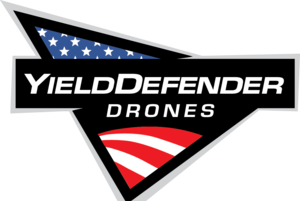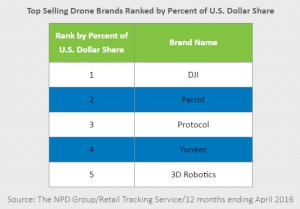Podcast: Play in new window | Download (Duration: 30:54 — 17.8MB)
Subscribe: Google Podcasts | Email | RSS
A manned aircraft manufacturer looks ahead to UAS, whale-watching drones, ADS-B for UAS, a report on U.S. drone retail sales, and the U.S. Commerce Department issues privacy guidelines.
News
Air Tractor® Makes Entry into the UAS Market – Acquires Yield Defender
Air Tractor, Inc. produces a number of manned agricultural aircraft: 400, 500, 600 and 800-gallon capacity airplanes powered by Pratt & Whitney Canada PT6 turbine engines. But they’ve seen the future, and it’s unmanned, so they’ve purchased Hangar 78 UAV and its Yield Defender unmanned aerial system.
 Air Tractor President Jim Hirsch says, “We have done our research, and it’s clear that aggressively investing and further developing unmanned aerial systems into agriculture will enable Air Tractor to remain an industry leader and provide the latest technology to ag producers as UAS capabilities mature and are integrated into the industry.”
Air Tractor President Jim Hirsch says, “We have done our research, and it’s clear that aggressively investing and further developing unmanned aerial systems into agriculture will enable Air Tractor to remain an industry leader and provide the latest technology to ag producers as UAS capabilities mature and are integrated into the industry.”
Yield Defender UAS systems are engineered for the agriculture industry. Their UAS has Near Infrared (NIR) sensors, thermal imaging, and Light Detection and Ranging (LIDAR) technology.
PWWA looks toward regulations of whale watching drones
The Pacific Whale Watch Association wants to make sure whales remain wild. They recognize the research value of drones, but they don’t know if hobby drones disturb whales. Additionally, they say current laws are vague or don’t exist. For now, PWWA asks drone operators to follow the Whale Wise Guidelines: stay at least 200 yards outside the perimeter of a whale or pod, and more than 400 yards from the path of a traveling pod.
Obstacles Appear to Extending GPS-Based ADS-B for UAV Operations
Inside GNSS published a comprehensive article that looks at issues and possible solutions for using the automatic dependent surveillance-broadcast (ADS-B) system on unmanned aircraft. The FAA has mandated installation of the ADS-B system in manned aircraft by 2020.
Obstacles to using ADS-B on UAVs include: cost, weight, and large numbers of drone flights. Also, many areas in the U.S. do not have ADS-B coverage below 500 feet.
Harris Corporation, the FAA’s prime contractor for ADS-B, announced ADS-B Xtend, a dual-band receiver and relay system that can be installed in areas without close-to-the-ground ADS-B capabilities. It provides UAV operators with aircraft tracking data, maps, and weather information.
Harris is partnering with PrecisionHawk to include information from the Low Altitude Tracking and Avoidance System or LATAS, which uses cellular networks. The Xtend ground receivers have a 150-mile range, and they can be attached to existing structures or even to mobile vehicles for roaming coverage.
Drone dollar sales for the past 12 months were three times higher than sales from prior year
 Retail research firm The NPD Group released a report that says for the twelve months ending in April, drone sales have grown 224 percent year-over-year to nearly $200 million.
Retail research firm The NPD Group released a report that says for the twelve months ending in April, drone sales have grown 224 percent year-over-year to nearly $200 million.
Drones with 4K cameras accounted for more than one-third of dollar sales, and drones with built-in GPS accounted for 64 percent of revenue. Drones with an average price greater than $500 accounted for 56 percent of dollar sales and drones sold during the 2015 holiday season increased 445 percent from the prior year.
Privacy fears: Panel has advice for drone operators
The Commerce Department’s National Telecommunications and Information Administration has released the 8-page Voluntary Best Practices for UAS Privacy, Transparency, and Accountability. [PDF] The best practices are directed to both commercial and non-commercial drone users.
The document describes voluntary best practices, many relating to the collection of “Covered Data,” or information collected by a UAS that identifies a particular person. Due to First Amendment issues, the guidelines do not apply to newsgathering and news reporting organizations. The appendix lists eight guidelines for “Neighborly Drone Use.”
Video of the Week
Drone Roof Inspection
In this video, listener Ken Krantz uses a drone to inspect his solar panels and pool heating apparatus, with a little humor thrown in. The inspection actually revealed a broken item in need of repair. Ken tells us, “I should point out that, before this flight, I called my local tower and filled out a DROTAM that included the time of my flight, the max altitude (I specified 150’) and a number I could be reached at should they need to retract the DROTAM permission. AND, of course, I have an FAA UAS registration number affixed to the craft.”
Mentioned
UAV Propulsion Tech is a sponsor of The UAV Digest, and President Bob Schmidt has created a LinkedIn group called UAV Tech, “a networking group for technical people in the unmanned aerial vehicle industry. It will focus on advanced technology for UAV’s like: propulsion, payloads, servos, autopilots, sense/avoid, launch/recovery, generators, parachutes, airframes, materials, applications, and testing.” Group membership is by request.
New drone racing sport taking off in Utah
Patrick sent us this article that describes how a man who bought a toy quadcopter for his son ended up designing custom drones and became involved with Drones, Etc., an online business founded in early 2013 by two professional aerial enthusiasts.
